Australia PR Visa – Eligibility & Immigration Pathways
Securing Australia Permanent Residency (PR) is more than just a visa, it’s your ticket to a stable, high-quality life for you and your family. With PR, you can live, work, and study anywhere in Australia, access Medicare healthcare, enjoy free education for your children, and benefit from a five-year travel facility that allows you to leave and return to Australia freely.
Australia is welcoming skilled professionals like never before, with over 160,000 PR visas granted recently. Opportunities are booming across IT, Engineering, Healthcare, Accounting, and many other in-demand sectors, making it the perfect time to plan your move.
Why to Apply for Australia PR?
- Ranked as the 8th happiest country globally
- Welcoming 500,000 new migrants in 2024
- 800,000 job openings available for skilled workers
- Australia PR offers up to 100-fold return on investment
- Access to comprehensive Universal Healthcare services
- Complimentary education for your children in public schools
- Eligibility for retirement benefits as a permanent resident
- Simplified and straightforward path to Australian citizenship
Australia PR Process
Australia PR Process: Three Different Stages
The process of obtaining Australia PR can be broadly divided into three key stages:
1. Australia Skill Assessment
First, your qualifications and work experience need to be assessed by the official authority for your occupation. This shows you meet Australian standards without this, you can’t move forward.
2. Apply for PR
Once your skills are approved, submit your application along with an Expression of Interest. You’ll need to meet requirements like age, English, health, and character checks. After approval, you’ll get your PR visa giving you the freedom to live, work, and study anywhere in Australia.
3. Prepare to Move
Now comes the exciting part: planning your move! Organize your documents, book your travel, and get familiar with your rights as a permanent resident. The visa comes with a five-year travel facility, and after four years in Australia, you can apply for citizenship.
* Need guidance to apply for Australia PR? Get expert advice with Migrate to Australia!
Types of Australian PR visa
Australia offers several permanent visa pathways, depending on your skills, background, and reason for migrating. Whether you're a skilled professional, have family in Australia, or want to invest or start a business, there's a PR visa option designed for your profile.
Choosing the right visa stream is the first step toward building a future in Australia.
Skilled Migration Visas
- Skilled Independent Visa (subclass 189)
- Skilled Nominated Visa (subclass 190)
- Regional Skilled Visa (subclass 491)
- Employer-Sponsored Visa (subclass 186)
- Graduate Work Visa (subclass 485)
- Professional Year Program (PYP)
Family & Special Category Visas
- Family Stream Permanent Visa
- Australia Parent Visa
- Special Category Visa (SCV)
- Subclass 891 Visa
Business & Innovation Visas
Eligibility for Australian PR
If you're planning to move to Australia permanently, it's important to first check whether you meet the basic eligibility requirements. These criteria help determine if you qualify for a skilled migration visa. Below are the eligibility criteria to apply for Australia PR:
- Age limit: Generally under 45 years old at the time of application.
- Points test: Minimum 65 points based on age, English proficiency, work experience, education, and other factors.
- Occupation: Must be listed on the Skilled Occupation List (SOL).
- Health and character: Must pass medical examinations and police checks.
- English language proficiency: Competent level demonstrated through tests such as IELTS or PTE.
- Residence requirement: For citizenship eligibility, permanent residents must have lived in Australia for at least four years. Meeting these criteria improves the chances of a successful application.
Australia PR Requirements
A minimum score of 65 points is required to qualify for an Australia PR visa. Achieving a higher score on the eligibility assessment increases your likelihood of receiving an invitation to apply for Australia PR. Candidates scoring between 80 and 85 points may become eligible for a faster invitation process. There are multiple visa categories available for applying for Australia PR, each with its own specific eligibility criteria. However, the general eligibility factors include the following:
- Have a valid skills assessment from a relevant assessing authority.
- Achieve a minimum score of 65 points on the points test
- Submit a valid Expression of Interest through SkillSelect (for skilled visas).
- Provide evidence of English proficiency.
- Meet health and character requirements.
- Have a valid passport or travel document.
- Submit all required documents, including identity, work experience, and educational qualifications
- Pay the applicable visa application fees
To qualify for an Australian Skilled Migration visa (Subclass 189, 190, or 491), applicants must score at least 65 points on the points test. The system rewards age, education, work experience, English proficiency, and other factors. Higher points improve your chances of receiving an Invitation to Apply (ITA).
| Category | Maximum Points |
|---|---|
| Age (25–32 years) | 30 points |
| English proficiency (8 bands) | 20 points |
| Work Experience outside Australia (8–10 years) | 15 points |
| Work Experience in Australia (8–10 years) | 20 points |
| Education (outside Australia) | 20 points |
| Doctorate degree | 10 points |
| Niche skills such as Doctorate or master’s degree in Australia | 10 points |
| Study in regional Australia | 5 points |
| Accredited in community language | 5 points |
| Professional year in a skilled program in Australia | 5 points |
| State sponsorship (subclass 190 visa) | 5 points |
*Want to check your eligibility for Australia? Avail FREE Y-Axis Australia PR Points Calculator and get an instant score!
How to apply for Australia PR?
Below are the application process for Australian permanent residency:
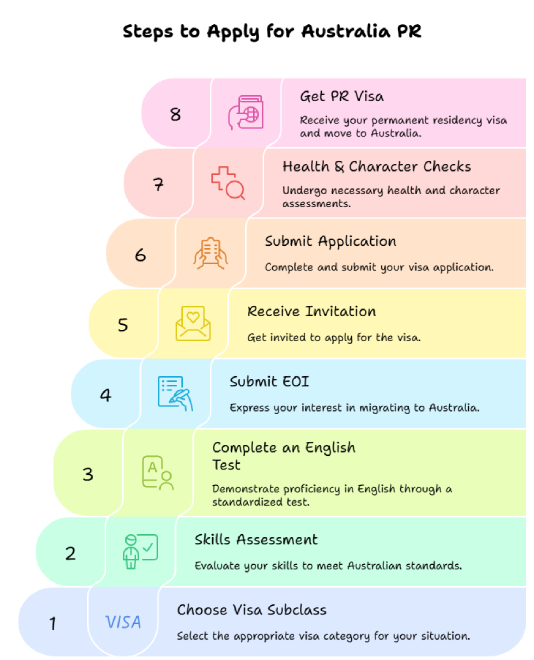
Step 1: Choose the Right Visa Subclass
Choosing the correct visa subclass is crucial as it aligns with your occupation, skills, and personal situation. Different subclasses cater to various pathways such as skilled migration, employer sponsorship, or family sponsorship.
Step 2: Get a Skills Assessment
This assessment verifies that your qualifications and work experience meet Australian standards. It is mandatory for most skilled visa applications and must be conducted by the relevant assessing authority for your occupation.
Step 3: Complete an English proficiency test
Demonstrating competent English language skills through tests like IELTS or PTE is essential to meet visa requirements and improve your points score on the points test.
Step 4: Submit an Expression of Interest (EOI)
An EOI is an online application where you express your interest in applying for permanent residency. It includes details about your skills, qualifications, and experience and allows Australian authorities to assess your eligibility.
Step 5: Receive an invitation to apply for PR
If your EOI meets the criteria and there are available places, you will be invited to lodge a formal application for permanent residency.
Step 6: Submit all important documents & complete Australia PR application
Submit your application along with all necessary documents such as identity proof, skills assessment results, English test scores, and health and character certificates.
Step 7: Complete Health and Character Checks
These checks ensure you meet the health and character requirements set by the Australian government for all visa applicants.
Step 8: Get Your PR Visa and move to Australia
Once approved, you can live, work, and study in Australia indefinitely. Your visa includes a five-year travel facility for leaving and returning freely.
* Need guidance to apply for Australia PR? Get expert advice with Migrate to Australia from our trusted migration consultants.
How to Renew Your Australian PR Visa?
Australian Permanent Residency (PR) visas do not typically require renewal. However, if you're looking to maintain your visa status or plan to re-enter Australia after a certain period, you may need to apply for a Resident Return Visa (RRV) to keep your permanent resident status intact. Here's how you can apply:
Steps to Apply for RRV:
-
Check Eligibility: Confirm you meet the requirements, such as residency in Australia or strong ties to the country.
-
Prepare Documents: Gather your passport, proof of residence, and evidence of ties (family, employment, or business).
-
Complete the Application: Apply online via the Department of Home Affairs or submit a paper application. Upload all necessary documents.
-
Pay the Fee: RRV fees range from AUD $165 to $365, depending on the type.
-
Submit the Application: Send it online or via the relevant Australian consulate if applying from abroad.
-
Wait for Processing: Usually 1–2 weeks for online applications; may take longer if additional documents are requested.
-
Receive Your Visa: Once approved, you get the RRV, maintaining your PR status and travel rights.
Benefits of Holding Australia PR
Securing an Australia Permanent Residency (PR) visa opens the door to a wide range of benefits for skilled professionals and their families. Beyond the right to live in Australia indefinitely, PR holders enjoy access to healthcare, education, and social services, while also building a pathway toward citizenship. Below are the key advantages of becoming an Australian permanent resident:
- Unrestricted Work Rights – Work in any job, for any employer, across Australia without limitations.
- Healthcare Access (Medicare) – Enjoy subsidized healthcare services under Australia’s public health system.
- Education Benefits – Children can attend government schools at local rates and access higher education at domestic student fees.
- Citizenship Pathway – Apply for Australian citizenship after meeting residency and character requirements.
- Government Services & Benefits – Access to certain welfare benefits and services after a qualifying period.
- Family Sponsorship – Sponsor eligible family members to join you as permanent residents.
- Travel Flexibility – Multiple re-entry rights into Australia with visa renewals available for long-term stays.
Top High-Demand Jobs in Australia
Australia continues to experience skill shortages across key sectors, creating strong opportunities for qualified migrants. If your background matches a high-demand occupation, your chances of getting a PR invitation increase significantly.
In 2025, the most in-demand sectors and their average salaries include:
| Occupation | Annual Salary (AUD) |
|---|---|
| IT | $99,642 – $115,000 |
| Marketing & Sales | $84,072 – $103,202 |
| Engineering | $92,517 – $110,008 |
| Hospitality | $60,000 – $75,000 |
| Healthcare | $101,569 – $169,279 |
| Accounting & Finance | $77,842 – $92,347 |
| Human Resources | $80,000 – $99,519 |
| Construction | $72,604 – $99,552 |
| Professional & Scientific Services | $90,569 – $108,544 |
If your job role is listed on the Skilled Occupation List (SOL), and you meet other eligibility requirements, your path to PR can be faster and more straightforward.
Australian PR Fee
Securing an Australian Permanent Residency (PR) Visa involves paying government visa application charges (VAC) along with associated costs for skills assessment, English proficiency tests, medical examinations, and police clearance. The table below provides the latest fee structure for key skilled migration visas.
| Visa Subclass | Primary Applicant | Adult Dependent Fee | Child Dependent Fee |
|---|---|---|---|
| Subclass 189 (Skilled Independent) | AUD 4,910 | AUD 2,455 | AUD 1,230 |
| Subclass 190 (Skilled Nominated) | AUD 4,910 | AUD 2,455 | AUD 1,230 |
| Subclass 491 (Skilled Work Regional) | AUD 4,910 | AUD 2,455 | AUD 1,230 |
Fees are applicable for applications lodged on or after 1 July 2025.
Other costs include:
- Skills assessment fees: AUD 300 to AUD 1,000+
- English tests: AUD 300 to AUD 400
- Medical examinations: AUD 300 to AUD 500
Australia PR Visa Processing Time
Processing times for Australia PR applications depend on the visa subclass and the individual case. On average:
| Visa Subclass | Estimated Processing Time |
|---|---|
| Subclass 189 (Skilled Independent) | 8 to 12 months |
| Subclass 190 (Skilled Nominated) | 6 to 12 months |
| Subclass 491 (Skilled Work Regional) | 9 to 12 months |
Tips to Get Your Australian PR Visa Processed Faster
Delays in Australian PR visa processing often happen due to incomplete applications or missing documentation. To speed up your PR process and increase your chances of approval, follow these expert tips:
-
Complete Your Application: Ensure all forms and documents are ready to avoid delays.
-
Get Skills Assessed Early: Have your qualifications and work experience reviewed by the official assessing authority.
-
Prepare English Test Scores: Keep IELTS, PTE, or TOEFL results ready; higher scores boost points.
-
Choose the Right Visa: Select the appropriate subclass (189, 190, 491) based on your profile.
-
Align Your Occupation: Pick the correct occupation from the Skilled Occupation List (SOL) matching your experience.
-
Finish Health & Character Checks: Complete medical exams and police certificates early.
-
Monitor Your Application: Track your progress on ImmiAccount and respond promptly to requests.
Common Reasons for PR Visa Rejection
Here are common issues that can hold up your PR application:
- Choosing the wrong visa type for your situation
- Missing or incorrect information
- Problems with health or police checks
- Low English test scores
- Not showing proof of funds
- Inconsistent or unclear documents
- Past visa issues
Australian authorities take documentation seriously. Submitting false information or conflicting records can lead to long-term bans from reapplying.
Mistakes to Avoid in Your Australia PR Application
To improve your approval chances, avoid the following errors:
- Contradictory information in your resume, application, or online profiles
- Skipping essential documents or requirements
- Failing to review your application thoroughly before submission
- Reapplying without addressing previous application issues
- Not declaring criminal convictions or other background issues
Engaging a trusted migration consultant can help ensure your application is accurate, complete, and strategically prepared to meet Australian immigration standards.
How Can Y-Axis Help You with Australia PR?
Getting Australia PR can feel overwhelming but you don’t have to do it alone. With over 15 years of experience, Y-Axis has supported lakhs of people in successfully moving to Australia. The team understands how the process works and what it takes to get your application right the first time.
At Y-Axis, you get:
- Free eligibility check through the Australia Immigration Points Calculator
- Expert guidance/counseling for Australia Immigration
- Coaching services: Expert PTE coaching, IELTS proficiency Coaching
- Free career counseling; book your slot today
- Complete guidance for Australia PR visa
- Job search services to find related jobs in Australia
By offering end-to-end support, Y-Axis ensures applicants have a smooth and efficient journey towards obtaining Australian permanent residency.
Take the first step toward your Australia PR – Book your free consultation now.
Looking for Inspiration
Explore what Global Citizens have to say about Y-Axis in shaping their future
Frequently Asked Questions

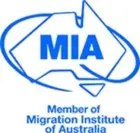
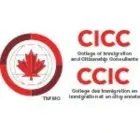
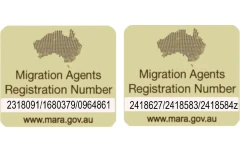
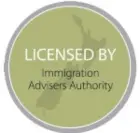
.webp)

.webp)

